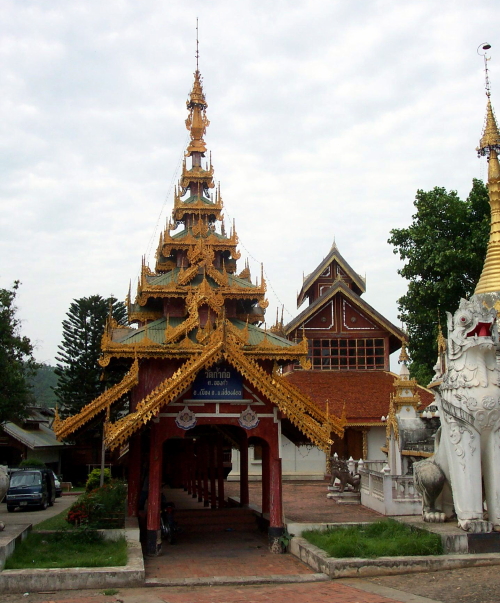
The covered entry to Wat Kam Ko
The most interesting things to see in Mae Hong Son town are its many Shan style temples. These are quite distinct architecturally from other temples in Thailand.
The most noticeable difference are the large wooden wiharns (prayer halls). In Mae Hong Son, these are usually open-fronted and the roofs will be trimmed with lace-like fretwork in silver, white or gold.
The ubosots (ordination halls) are usually the only buildings in stone in Mae Hong Son temples. They are also generally very small compared to temples in central Thailand.
- Wat Hua Wiang
- Next the the city's bustling market is the large temple compound of Wat Hua Wiang. The main feature of the temple is its recently restored huge multi-gabled wooden wiharn, housing a revered Buddha image.
- Wat Jong Kam
- Sharing the same grounds as Wat Jong Klang is Wat Jong Kam. If it appears just a little less old and elaborate than its neighbor, its because much of the temple was destroyed by fire in 1970. The only remaining significant structure is the very unusual ubosot (ordination hall), which is a large rectangular slab with several chedis on the roof.
- Wat Jong Klang
- Set on the south side of Jong Kam lake in the middle of town, Wat Jong Klang's white and gilded chedi has practically become a symbol of Mae Hong Son. Behind the chedi is a large rambling open-fronted wiharn.
- Wat Kam Ko
- Kam Ko (or Kam Kaw) temple isn't featured in most guidebooks, but its right across the street from Wat Phra Non and well worth a visit. The temple appears to date from around 1901. Like all temples in Mae Hong Son, Wat Kam Ko is distinctly designed and decorated in the Shan style with delicate 'doily' like fretwork.
- Wat Muo Taw
- Next to Wat Phra Non at the base of Doi Kong Mu is the temple of Muo Taw. Although its impossible to miss, this curious and obviously old temple is not in any guidebook, Thai or English, to the city. The temple lies next to one path leading up to the Wat Phra That Doi Kong Mu temple on top of the hill.
- Wat Phra Non
- At the base of Doi Kong Mu is the small temple of Wat Phra Non (or Pra Nawn), which literally means 'temple of the reclining Buddha'. Its no surprise then that the major feature of the temple is a large reclining Buddha statue. The statue was commissioned in 1877 by Rama V and is rather more lifelike than most. The temple itself was started around 1875 as a resting place for the king.
- Wat Phra That Doi Kong Mu
- The temple atop Kong Mu hill, Wat Phra That Doi Kong Mu, affords a spectacular view of the entire valley in which Mae Hong Son is nestled. The temple itself is notable for its two large white chedis and its typical Shan architecture.